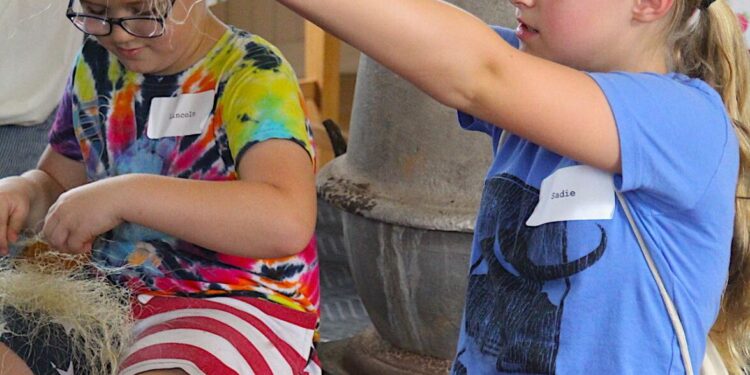How can kids learn about history without staring into a school book? Very easy. They have to relive it.
That’s the strategy of Ian Swart, living history interpreter at the Museum of the Great Plains, 601 NW Ferris. Every year, the museum hosts the Schoolhouse Summer Camp, a week-long history camp designed to teach children history in a hands-on way.
“History is not just dates, names and places,” Swart said. “It’s the story of real people about their day-to-day life.”
The Schoolhouse Summer Camp consists of many different areas and topics, such as an art day or the science of the weather where the kids could learn and explore how to read a wind speed reading instrument, among many other things. On another day, they got to learn about a typical day at school 100 years ago. And last Wednesday, the children were taken back into the cattle drive era, the era of the cowboys, from the 1860s to the 1880s.
“It’s very applicable to this region,” Swart explained, adding it was because of Lawton’s strategic location between the Chisholm Trail and the Great Western Trail. The two trails were main paths for moving cattle to the closest railheads in Kansas, where they were put on trains and shipped to the East Coast, which had a huge demand for beef after the Civil War.
“We want to highlight history that’s unique here,” Swart said.
Last week, children learned how to make quick and easy biscuits with only three basic ingredients: self-rising flour, lard and butter milk.
“We talked about the different ingredients, and they then helped with every step, stirring it and shaping the biscuits,” Swart said. Later, the kids were able to taste and eat the self-made biscuits.
Peyton Ball, 9, and Sadie Perkins, 10, said making biscuits was one of their favorite activities. A main motivation for Ball to attend the camp in the first place was to see his friends, but he said he enjoyed making biscuits and building a wagon.
“I’m happy if the kids go home and are excited to see how people did things a long time ago,” Swart said. “Fostering history in kids is very rewarding.”
After tasting the biscuits, Swart then introduced the kids to the art of making a fire using only flint and steel as well as a rope made of char cloth. This method, he said, has been used for thousands of years.
“We start with a natural fiber rope and then pull the fibers apart to make a bird’s nest,” Swart explained.
The fabric, he said, was made of char cloth, which flames easily. Swart then demonstrated how to start the fire, using flint and steel to ignite a spark and transfer it onto the bird’s nest.
The camp was held in the museum’s schoolhouse from 1902, which originally was Blue Beaver School 11 miles from the museum. Later, it was put on wheels and brought to the museum’s grounds. In 2002, it reopened after renovations and refurbishments.
“It’s very rewarding to have this old building,” Swart said.
Want to reach a local audience and grow your business?
Our website is the perfect platform to connect with engaged readers in your local area.
Whether you're looking for banner ads, sponsored content, or custom promotions, we can tailor a package to meet your needs.
Contact us today to learn more about advertising opportunities!
CONTACT US NOW





